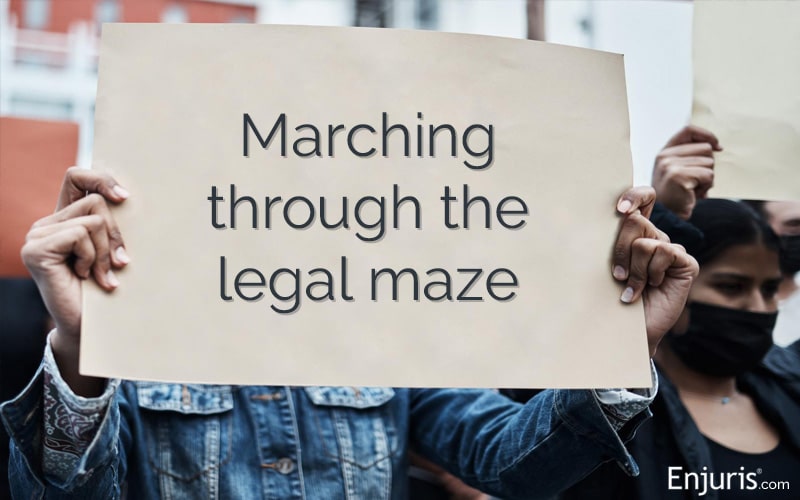[ad_1]

On a beautiful Saturday morning, you board the number 27 bus to the heart of downtown, eager to join thousands of fellow citizens in a peaceful protest. As passionate chants fill the air and handmade signs sway above the crowd, the atmosphere is inspiring. But suddenly, without warning, a violent altercation breaks out a few feet from where you stand. Before you can react, the turmoil escalates, leaving you with a broken arm and a mild traumatic brain injury.
Amid the pain and confusion, one question lingers: Can the organizers of the protest be held liable for your injuries?
Understanding the First Amendment
The First Amendment of the United States Constitution guarantees the right of the people to peacefully assemble:
“Congress shall make no law respecting an establishment of religion, or prohibiting the free exercise thereof; or abridging the freedom of speech, or of the press; or the right of the people peaceably to assemble, and to petition the Government for a redress of grievances.”
While the First Amendment protects the right to protest, it doesn’t completely shield organizers from the responsibilities and potential liabilities that might arise from their event.
How NAACP v. Claiborne Hardware Co. shapes protest organizer liability
A 40-year-old United States Supreme Court case established that protest leaders are constitutionally protected from liability for unlawful acts by other demonstrators, so long as the organizers don’t specifically direct or incite imminent violence.
Let’s take a closer look at the case:
Case name: NAACP v. Claiborne Hardware Co., 458 U.S. 886 (1982).
Facts: In 1966, during a meeting of the NAACP in Claiborne County, Mississippi, a boycott of white merchants was initiated to advocate for racial justice. While the boycott was primarily nonviolent, instances of violence emerged. In 1969, white merchants sued the NAACP for financial damages, including seven years of lost profits. A Mississippi Court held that the NAACP could be held liable for damages. The Mississippi Supreme Court upheld the lower court’s decision.
The case was appealed to the United States Supreme Court.
Question: Can an organization be held liable for damages caused by the acts of protestors?
Conclusion: In an 8-0 decision, Justice John Paul Stevens, writing for the court, effectively held that, under the First Amendment, protesters—including protest organizers—cannot be held liable for the unlawful acts of others that they did not direct, order, or incite.
Options for people injured at a protest
Given the precedent set by NAACP v. Claiborne Hardware Co., protest organizers are shielded from liability for injuries at a protest in most cases. However, this doesn’t mean injured protestors are without any legal recourse. Here are some parties that may still be held liable:
- The actual perpetrator: If a protestor is harmed by another individual, whether intentionally or negligently, the injured party can sue the assailant for damages.
- The local government: If the protest took place on public property, and it can be proven that insufficient security measures, poor maintenance, or a lack of necessary permits contributed to the injury, the relevant government entity could face liability.
- Private property owners: If an injury occurred on private property, the owner of the property could be held liable under premises liability laws if they failed to take reasonable steps to prevent foreseeable injuries.
- Security or law enforcement agencies: In instances where law enforcement used excessive force or acted negligently, they might be held accountable. However, this can be a complex avenue due to qualified immunity laws.
In personal injury law, when more than one party is at fault for an incident, the concept of shared fault comes into play.
Different jurisdictions handle shared fault in various ways. Here’s a general breakdown of the major systems:
- Pure comparative negligence: In these states, a plaintiff can recover damages even if they are primarily at fault, however, their compensation is reduced by their degree of fault.
- Modified comparative negligence: In these states, the injured party can only recover damages if they’re less than 50 percent of 51 percent (depending on the state) at fault. What’s more, their damages are reduced by their percentage of fault.
- Contributory negligence: In these states, the plaintiff is prohibited from recovering damages if they’re found even one percent at fault for the incident.
Given the complexities of First Amendment cases, qualified immunity, and shared fault, it’s important for anyone who is injured at a protest to seek legal counsel. Fortunately, initial consultations are typically free.
[ad_2]



